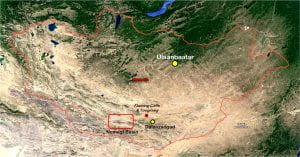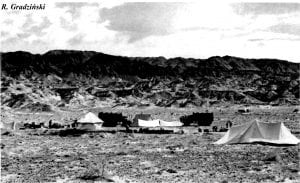Guest Author – James Ormiston
Bristol Palaeontology MSci Graduate / Palaeo Artist
Of the many countries around the world that have seen palaeontologists scouring their strata for fossils, Mongolia is one of the most intriguing and inspiring. Landlocked and sandwiched between its neighbouring geographical behemoths, Russia and China, Mongolia is itself a very large country. Across 1.5 million square kilometres The Country of Blue Sky’s expanse covers parts of the Altai Mountains in the north, the Gobi Desert in the south, and vast grassland steppes in between. Such a landscape, along with its sparse human population, certainly calls to mind the kind of place where you’d expect to see a small gaggle of sunburnt scientists under their wide-brimmed hats chipping away at nature’s time capsules. And since the early 20th Century that’s exactly what has happened.
Although outsiders had been venturing into Mongolia to investigate its geography and geology for many years prior, the expeditions of American explorer Roy Chapman Andrews in the 1920s is one of the best known. They were actually searching for evidence of early humans, but became famous for a trove of discoveries much older. Along with the first ever reports of preserved dinosaur eggs, the expedition leader was immortalised in the species named Protoceratops andrewsi, which was discovered by his photographer. Mongolia’s southern region had thus been earmarked as a target for future exploration. In the following decades a number of joint expeditions were made by teams from Russia, and Mongolia itself, identifying additional outcrops. Although study was suspended during the Second World War, more Russian teams (led by Ivan Yefremov) continued after peace returned, and further cooperation with China explored other parts of the Gobi outside Mongolia’s borders. In this new political climate it became difficult for western countries (especially non-Soviet ones) to return to the region.
Enter the Polish Academy of Sciences. In the early 1960s a team was put together and signed an agreement to work with their Mongolian counterparts in an effort to build on the work of previous expeditions. Roman Kozłowski, known for his work untangling the mysteries of graptolites, was the project’s initiator. One of the principal hurdles to overcome was the massive distances involved. This not only applied to the journey from Poland to Mongolia but also the work in Mongolia itself. In the 1960s Mongolia was even more sparsely populated than it is today (just short of 1 million people on the 1960 census, today there are closer to 3 million), and it was realised that the field sites would be at times hundreds of kilometres from the nearest settlements. As such, the expeditions would have to be completely self-sufficient. All the equipment needed was assembled in Poland and sent by rail to the Mongolian capital Ulaanbaatar a whole two months before the teams arrived, who then spent two weeks repacking all of it.
The sites of interest were in the Southern Gobi. These places were so remote that a secondary store for equipment and finds was established in the nearest city, Dalanzadgad, which was itself 400 kilometres away. The desert conditions called for a reliance on motor transport in the form of Polish, Czech and Soviet-built trucks and jeeps. Over the course of the first wave of expeditions at least two of these would break down and require repair in the Mongolian wilderness. They were also essential for maintaining an adequate water supply, and at one point a truck was required to drive through 40 kilometres of sand dunes to the nearest well every 3-5 days, bringing 600 litres each time. The Mongolian climate didn’t help matters either. Despite being known for its clear skies, the country’s strong winds overturned many of the European-style tents the Polish team brought with them on the first expedition in 1963, and as a result they later took on the more proven Mongolian-style tents instead (using sail canvas, two large supporting rods and no floor).

As with any palaeontological expedition, accounting for all the equipment needed for excavating and transporting fossils was also no small task. As recalled by team members Zofia Kielan-Jaworowska & Naydin Dovchin, the 1965 expedition required: “…among others: 20 pickaxes, 20 picks, 33 spades, 40 hammers, 100 chisels of various sizes, 50 paint brushes, 50 scrapers, 1 hand-pulley, 2 mechanical puIIies (on the trucks), a set of carpentry and locksmith tools…120 litres of liquid polystyrene were used, 2 tons of plaster, 150 sq. metres of canvas, 75 kg cellulose paper, 300 kg of wood shavings, 200 sq. metres of corrugated cardboard, 5 cubic metre boards for crates, 70 kg nails, 100 ready-made crates…14,000 litres of petrol were taken from Poland for the three Polish trucks.” On top of this, at times it was required to recycle used equipment for other purposes, setting up temporary carpentry workshops. For example, makeshift sledges for large fossil-containing structures (called monoliths, consisting of polystyrene surrounding the fossils, all contained in a wooden frame – they weighed up to 2.5 tons each) were made out of discarded petrol drums. The sledges were pulled along roads that had to be made by levelling the ground. It was hard work, but it enabled them to collect 35 tons of material in the first three years.
The 1963 expedition did not conduct much in the way of excavations. Instead it was used as a reconnaissance trip to establish where specifically the next expeditions should look for Cretaceous and Tertiary age deposits (the Tertiary is no longer in use as a period of time). Things looked promising, and an itinerary of equipment was drawn up for later use. It was decided to divide excavation work between the Nemegt Basin and an area called Bain Dzak, also known as the Flaming Cliffs. Part of the Flaming Cliffs contingent would also be the first to explore new sites south of the Altai Mountains.

About a month after arriving in Mongolia for the second expedition, the teams were already coming across some excellent fossils. The large tyrannosaur Tarbosaurus had been reported by previous expeditions, and the teams managed to find more specimens of this genus at a site called Tsagan Khushu. This site also yielded many fossils of crocodilians, fish and wood. Other known dinosaurs were recovered too, like the ankylosaur Pinacosaurus and the aforementioned Protoceratops found at the Flaming Cliffs sites, as well as numerous Cretaceous mammal remains. Excitingly, potential new species were found, including two unfamiliar ornithomimid dinosaurs at Tsagan Khushu. During this time the Tsagan Khushu site was engulfed in a sandstorm, which left every tent overturned. To the west, the team tasked with finding new outcrops near the mountains came across an Oligocene exposure extremely rich in fossils. They collected hundreds of lagomorph, rodent and insectivorous mammals in less than half a day.
After the success of the summer of 1964, much of the equipment remained in Mongolia until the next expedition arrived the following year. The plan was to split again into two groups, one based in the Nemegt Basin and the other sent to the Flaming Cliffs. The two teams would then reunite in the Nemegt Basin later on, and another would form to investigate a place called Dzereg Valley to the west.
As before, the Flaming Cliffs proved a bountiful site revealing dinosaur eggs, more remains of Protoceratops, lizards and mammals. Part of the Nemegt team passed through on the way to their own site, this time joined by Mongolian palaeontologist Rinchen Barsbold (who would go on to become an influential proponent of study into the origin of birds and have a dinosaur named after him, the hadrosaurid Barsboldia, by fellow team members Halszka Osmólska and Teresa Maryańska in the 1980s). In the Nemegt Basin, the existing team established a handful of sites in a canyon area called Altan Ula. This was the locality which became notorious for its distance from a reliable water source. Despite the harsh conditions, it was Altan Ula that produced one of the most striking finds of the expedition: a near-complete skeleton of a large sauropod dinosaur reported as about 20 metres long discovered by geologist Ryszard Gradziński. The skeleton took almost two weeks to excavate, and was found on a high ledge that vehicles couldn’t reach. The trucks could only get within about half a kilometre of the site. Most of the bones were embedded in sandstone that couldn’t be easily broken, so they were wrapped in plaster as they were and placed in crates constructed at a workshop by the trucks (after being pulled on makeshift sledges).
Only a couple of days later, another significant find was made, this time by Zofia Kielan-Jaworowska. The team spent two days excavating her find: a pair of forelimbs belonging to some kind of unknown theropod dinosaur. That it was a new species was interesting enough, after all many more complete theropods had already been found, but this one was different. Attached to a preserved shoulder girdle and sporting impressive claws, these arms were an enormous 2.5 metres long. If you know your dinosaurs you may already know what these were found to belong to, but this shall be returned to later. A large specimen (14 metres long) of Tarbosaurus was also found around this time by a J. Małecki (whose first name I was unable to find in my research), but during its excavation and transport the only truck available for the job broke down. Subsequently only a hind limb and partial pelvis were recovered and the rest was unfortunately left behind. A few weeks afterwards, in late July 1965, the team sent westwards reached Dzereg Valley, but had to apply for permission from the authorities to enter as the area was under quarantine (the reason for this was not recorded in their published account).

In late August the teams wrapped up their camps and returned to Ulaanbaatar, where the collected fossils were divided up between the Polish and Mongolian academies. The Polish team then left in early September, ending their first series of extremely successful expeditions. They had found a huge wealth of Cretaceous fauna; an almost complete new sauropod, new species of ornithomimids, an almost complete Pinacosaurus, a new species of ornithischian, the huge arms of an unknown theropod, six specimens presumed to be Tarbosaurus in a range of sizes and prominent new Oligocene sites south of the Altai Mountains.
To be continued in Part Two!

